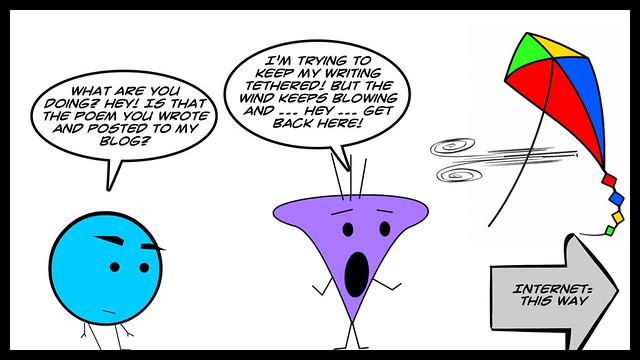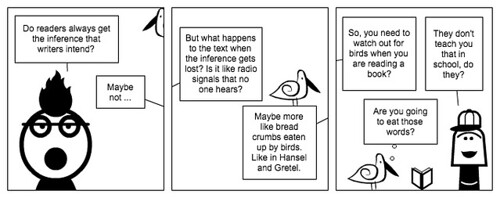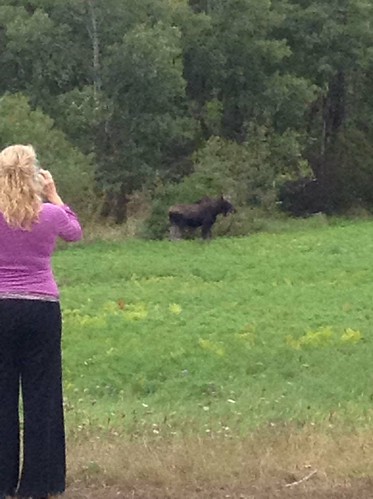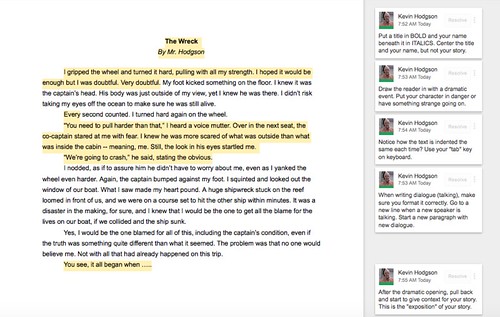Last night, the first day of the 4T Virtual Conference on Digital Writing kicked off, and one of the first sessions meshed nicely with my own teaching goals this year. Aram Kabodian, a friend from the National Writing Project (and fellow poet and middle school teacher), presented a session webinar about the benefits and logistics of digital writing portfolios. (He wrote about digital portfolios for Digital Is, too.)
This year, I have launched digital portfolios with my sixth graders, using our Google Apps for Education system. My professional teaching goal (and student learning goal) center around digital portfolios, so Aram’s webinar and resources were perfectly situated for what I am thinking deeply about and implementing right now.
Here are some of my takeaways from the sessions:
- I loved that he had us sharing out the oldest piece of writing that we still have. It reminded us about the power of the past, and how writing can connect us to who we were, and who we are. I wrote about a notebook of poems from high school that became the first steps into writing songs. I’m afraid to look at that notebook but I know where it is and what’s in it, and that writing is me, the past me;
- We talked and wrote with Aram about the rationale behind digital portfolios. There are some main reasons why one would use digital portfolios: to capture growth of a student over a set period of time, to document; to incorporate media into the collection; to share with parents what work is being done; to share with administrators; and to give students a representation of the writing they are doing (for future look-back moments);
- Aram explained how he assesses digital portfolios, using some focused literacy lens around writing standards connected to classroom lessons, and around the number and genres of pieces that students must work on throughout the year. To be honest, I have not yet gotten that far in my implementation, but I know I need to figure out assessment somehow that makes sense for students and myself;
- I was thankful that we spent time talking about how to nurture reflective stances by students, so that the reflective writing is part of the writing experience and of the digital portfolio itself. This requires scaffolding and modeling of reflection that goes deeper than the general ideas that most students fall into;
- Aram uses a wiki site for his portfolio system, and I wonder about whether a wiki really works, when thinking of reflection and public space, and also, ownership of writing (Whose space is it? Aram’s or his students’?). Aram says he can only keep a student page up for a year after they leave, and then it gets removed (otherwise, he has to foot the additional cost). It make me acknowledge that just about every platform right now that I have researched has its downside;
- I asked Aram about whether his use of digital portfolios is an isolated experience for students — if teachers in the grades above him also use portfolios, so that student growth might be seen over a longer period of time rather than a single grade. He said, no. He is the only one doing it, as far as he knows. I’m the same, I think. With Google, students can keep their writing for the next six years, from sixth grade to high school graduation …. what an opportunity that is, right? But I fear the potential for a true writing and learning portfolio might be lost if our district doesn’t see the merit;
- Aram’s webinar reminded me of where I need to go from here:
- I need to get my students doing more writing so that they have more to choose from in the end;
- I need to mull over the assessment of portfolios and how to make it meaningful;
- I need to work on lessons around more reflective writing practice;
- I need to think about what the writing portfolio will look like in June. Right now, they are collecting writing in Google Drive. Next up, we will make some folders. But eventually, as with Aram’s wiki site, I want students to carve out a place where they “present and publish” — with Google Sites, probably (although I get frustrated there, too);
- I should connect with the seventh grade teachers in our regional middle school system.
Overall, I learned quite a bit from Aram’s presentation at the 4T Conference, and I know I have a lot to think about and consider, and a lot to try out and figure out this year.
That’s the benefit of a pilot year, right?
Tinker, try, adjust, reflect, reset ….
Peace (inside the inside of the portfolio),
Kevin










